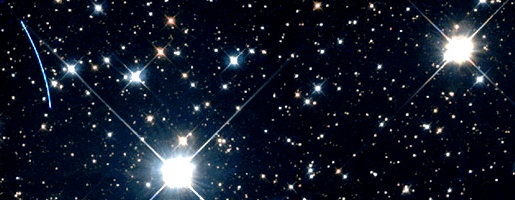 |
|||
|
An unnamed asteroid, one of thousands, leaves its trail
in a Hubble Space Telescope image.
|
|||
| NEAR-EARTH ASTEROIDS | |||
| Near-Earth Asteroids are defined as asteroids which have a perihelion of less than 1.3 AU (astronomical units), where the average distance between the Earth and Sun is defined as 1 AU. This distinguishes them from main belt asteroids which orbit within a large torus-shaped zone between Mars and Jupiter. There are far fewer NEAs than main belt asteroids. There are about 400. There are very likely many more, perhaps as many as several thousand 1 kilometre sized objects. NEAs are thought to be dead comets and asteroids which have been ejected from the main asteroid belt. The first NEA to be discovered, and also the second largest, was 433 Eros. | |||
| Atens, Amors, and Apollos. | |||
| There are three main groups of NEA classified according to their orbital characteristics - the Atens, Amors, and Apollos. | |||
| Atens are NEAs which move about the Sun in orbits smaller than the Earth's. So far, only a few dozen have been found. Just as Mercury is difficult to observe because it moves close the Sun, so are the Atens. There are probably very many more which go undetected, perhaps within the orbit of Mercury. | |||
| The Amors move near Earth's orbit, just outside the path of the Earth. These asteroids cross the orbit of Mars and approach the inner Solar System but do not overlap Earth's orbit. They have perihelion distances between 1.017 and 1.3 AU. | |||
| The Apollos cross Earth's orbit with a period greater than 1 year, have semimajor axes greater than 1.0 AU and perihelion distances less than 1.017 AU. | |||
| The Amors and Apollos make up the vast bulk of NEAs. The perihelion of the Apollos may bring them within Earth's orbit. Atens and Apollos have Earth-crossing orbits, that is, they may intersect with Earth's orbit. The Amors are said to be Earth-approaching, which simply means that they come close to the Earth. | |||
| Threats to Earth | |||
| Including expired comets there may be as many as 1000 NEAs. Most though, do not come anywhere near us. The name "near-Earth" Asteroid is perhaps a little misleading, but in planetary terms half a million kilometres is not very far at all. The largest near-miss of recent times was an object 70 metres across which passed at about the same distance as the Moon (384,000 kilometres) in 1996. The very smallest dust sized particles simply drift down, contributing hundreds of tons a year to the mass of the Earth. | |||
| Meteoroids in the millimetre to centimetre range are small asteroids which enter the Earth's atmosphere. Meteoroids pose little threat and usually burn up creating the streaks of light we call meteors. Larger meteors are called fireballs and are caused by small rocks, tens of centimetres across. Occasionally the Earth passes through the tail of a comet producing meteor showers, or the remnants of a main belt collision sent into a near-Earth orbit. To an extent, the atmosphere helps to shield us from meteorite impacts. The friction and stresses generated upon an object as it enters the atmosphere can cause it to burn up or fragment into smaller pieces. | |||
| Asteroids in excess of about 50 metres are more dangerous. These are expected with a frequency of about 100 years. An impact by such an asteroid would cause a local disruption. If it impacted in the sea it would generate tsunamis which would drown low lying coastal regions. On this scale an event might compare with the Tunguska explosion over Siberia in 1908. Though the nature of the Tunguska impactor is still uncertain, possibly a stony-iron meteorite, its affects are well documented. Its airburst flattened a 2200 square kilometre area of forest, setting much of it alight. A similar sized object hitting the ground formed the 1.2 kilometre diameter Barringer Crater in Arizona, USA. | |||
| NEA origins | |||
| How did the NEA groups get to their present locations? Until recently the most popular explanation was that they were ejected from the main belt by alignments or resonances with Jupiter which sent them towards the inner Solar System. As they travelled through the main belt they collided with other objects and sent these into resonant orbits. The problem with the idea is that it seems unlikely such a large amount of material could be sent this way into the inner Solar System. | |||
| In the 1980s the mathematics of chaos theory were used to explain that objects near the 3:1 Kirkwood gap could undergo unpredictable changes in orbital configuration which allows them to switch to new orbits. The asteroids that end up as NEAs, or indeed any planet-crossing orbit, are unlikely to last more than a few million years. They end up crashing into the Sun or are ejected from the Solar System altogether. | |||
| The NEAs in terms of surface properties are very similar to the type of objects found near the 3:1 Kirkwood gap. They are the source of C-type (carbonaceous chondrite), S-type (stony-iron), and V-type (basaltic achondrite) meteorites. They are typical of the meteorite material which ends up on Earth. | |||
| More about asteroid geology | |||
| While most asteroids are thought to have originated near the 3:1 resonance, others may be dead comets. The rocky cores of comets may be very similar to C-type meteorites, making it hard to give a very accurate estimate. | |||
| A larger asteroid, say 1 kilometre across, would have far more significant effects, and global consequences. A body of such size might be expected with a frequency of 100,000 years. An impact by a 1 kilometre sized object would cause a global disaster. Landing in the sea, it would generate massive tsunamis which would cause devastation on far distant shores. | |||
| It is difficult to know the effects of a given sized impactor, because the damage it will cause depends on how fast it is going, the kind of materials of which it is made, and whether they are consolidated or just bound weakly. The effects of any impact much greater than 2 kilometres across will very likely be cataclysmic. Striking the surface, a 2 kilometre object would destroy an area the size of France with devastating global consequences. | |||
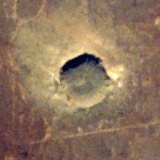 Meteor Crater, Arizona, too small to have a central uplift, but with raised crater rim and bright ejecta blanket. |
|||
| Severe environmental effects would result from the ejection of matter into the atmosphere. Gases and particles would block out sunlight, sufficient to initiate an ice-age. Asteroid induced climatic change may have wiped out the dinosaurs 65 million years ago. The impact responsible made a 180 kilometre diameter crater (Chicxulub Crater) in Southern Mexico, now embedded in the Yucatan Peninsula. | |||
 Variations in the gravity field off the Yucatan Peninsula, Mexico, reveal a large impact structure buried under the limestone bedrock. |
|||
| Happily no impacts of this size are predicted. But given time, 10 to 100 million years, large NEAs could collide with Earth and wipe out life. Some researchers have indicated that 433 Eros (35 kilometres across) itself has a fair chance of colliding with the Earth, in the next million years! | |||
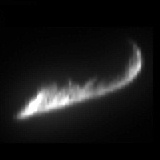 Highest resolution imagery of Eros. |
 The orbit of the Earth-approaching asteroid Eros. |
||
| However, it appears from the discovery of a new and large asteroid in an Earth approaching orbit, (1998 QS52), that our record of NEAs over 5 kilometres across is incomplete. In the next hundred years though, the greatest danger will be from smaller asteroids, less than 0.5 kilometres (big enough to destroy a major city) which have yet to be discovered. It is estimated that only about 10% of 1 kilometre sized asteroids have been detected. They are harder to see and are the reason for the interest in identifying all NEOs in this size range and obtaining accurate determinations of their orbits. | |||
| Searching and tracking | |||
| The first NEA discovered was Eros in 1898 - since then 400 or so have been found. But until the 1980s the pace of discovery was quite slow. As NEAs are faint and move quickly, only the larger objects, those above 5 kilometres across, could be recorded using photographic techniques. Recently, larger telescopes which are both sensitive and have a wide field of view, have accelerated the rate at which NEAs are found. | |||
| Two important tracking programs include NEAT (Near Earth Asteroid Tracking) which has an automatic observatory on Mount Haleakala, Maui, Hawaii. The other is Spacewatch based at Kitt Peak in Arizona. Spacewatch has located many NEAs including the 10 metre asteroid (1994 XM1) which made the closest recorded passage to the Earth at just 105,000 kilometres on December 9th, 1994. This distance is closer than the Moon. | |||
| These and other projects use large format CCD detectors to locate faint objects. CCDs (Charge Coupled Device) use an array of extremely sensitive elements to record an image digitally. Automatic telescopes can examine large swaths of sky in a night, the most effective, several hundred square degrees. They find objects by scanning a section of sky several times, and returning at intervals to identify moving objects amongst the background of stars. | |||
| The most successful project, however, is the LINEAR (Lincoln Near Earth Asteroid Research) program. LINEAR is based in Socorro, New Mexico, USA. In March 1998 alone, LINEAR discovered 13 new NEAs. The program, which uses a large format CCD array, is said to have increased the detection rate sixfold, locating, in addition to NEAs, thousands of other objects. | |||
| Catalysts for life | |||
| Asteroids and comets are worthy of study, not just as clues to the physical and geological evolution of the Solar System, but also to address questions surrounding the emergence of life itself. | |||
| Comets and asteroids have a dual significance for life on Earth. They are capable of destruction on a grand scale. But in extinguishing the dinosaurs, one such asteroid may have assisted the emergence of mammals and ultimately humans. They may even have played a more fundamental role by importing the basic components of life to Earth. | |||
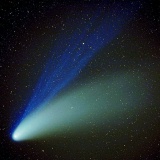 Ground-based view of the comet Hale-Bopp. |
|||
| During the late heavy bombardment (ending about 3.8 thousand million years ago), meteorites would have contributed to the heat of the molten Earth, residual from its accretion. Intense heat and heavy meteorite bombardment would not have permitted life to begin at this early stage. | |||
| More about Earth's evolution | |||
| As the Solar System formed, organic compounds like carbon dioxide and methane and molecules of ammonia and water concentrated in the outer Solar System. These condensed around rocky nuclei forming comets. Comets were abundant. They were perhaps also ejected in collisions with the gas giants and formed in the break-up of icy planetesimals. | |||
| Meteorites of the outer Solar System may also have gathered interesting ices on their surfaces, within their pore spaces, or amongst their loosely compacted bodies. | |||
| As the bombardment rate began to subside, a window of opportunity opened. The gases and organic compounds found in comets were dispersed in large and possibly repeated impacts upon the Earth. They would have been able to persist on the surface. Gases escaping from the interior of the cooling Earth would also have condensed and pooled on the new crust. | |||
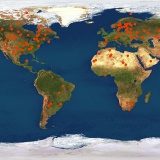 Known meteorite impact craters worldwide. Recorded sites are concentrated in well-explored regions such as North America and Australia. |
|||
| Experiments which combine simple molecules including carbon dioxide, methane, ammonia, and water, then subject the mixture to UV light or electricity, eventually form a brown soup. The soup is likened to the primordial oceans. With time molecules which are more complex than the original ingredients are present, the most significant of which are amino acids, the components of proteins. | |||
| More recent experiments have yielded compounds called purines and pyrimidines which form part of the structure of DNA, a molecule which in modern organisms is able to self-replicate and contains the information for building proteins. | |||
| Such trials show that life can begin very quickly given the right materials and conditions. The necessary components could have been delivered by comets and meteorites. Supposing Earth had not retained volatiles during its formation, it is quite conceivable that without these bodies, life would not have begun at all. | |||
| More about life on Earth | |||
|
|
|||